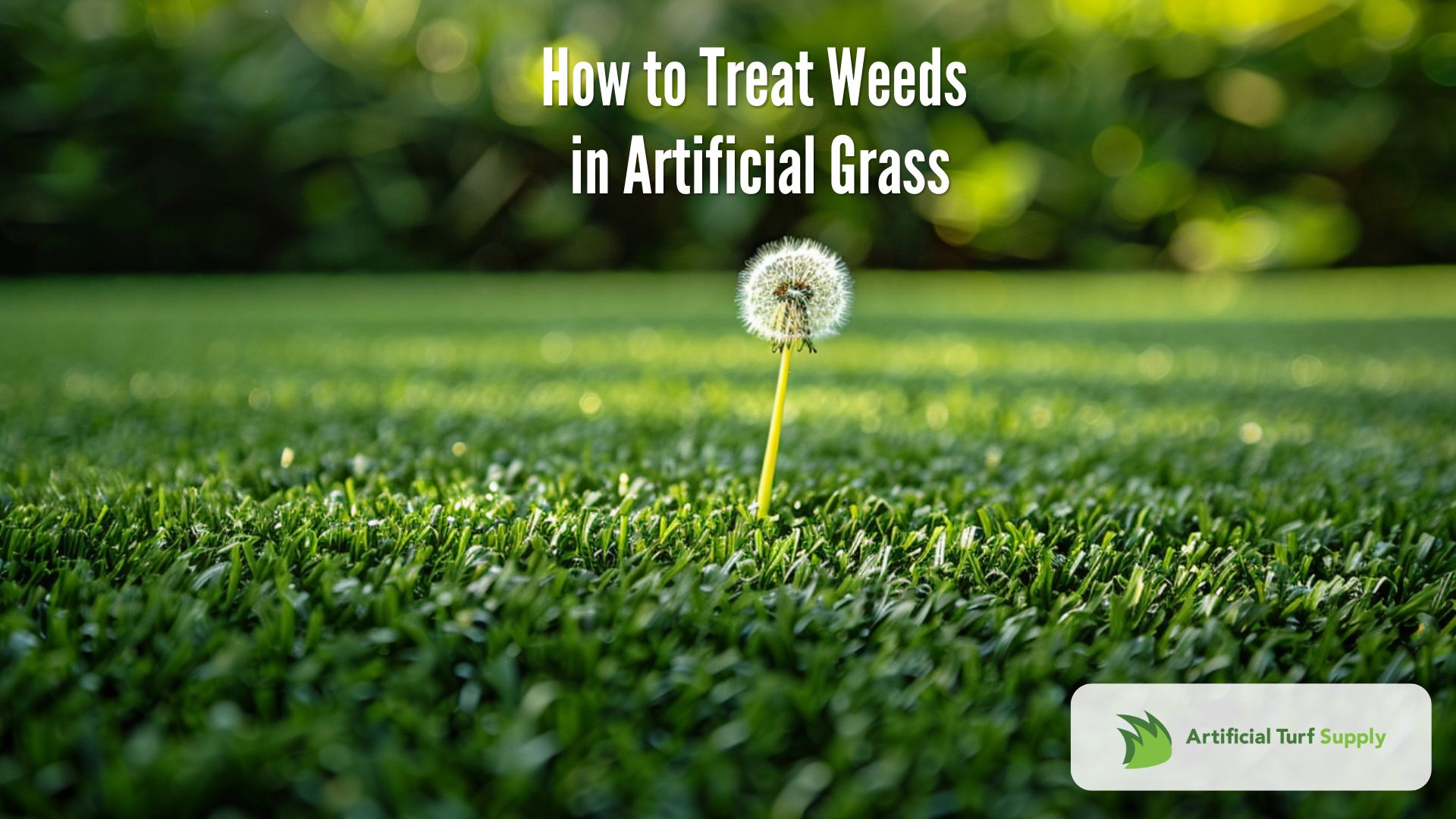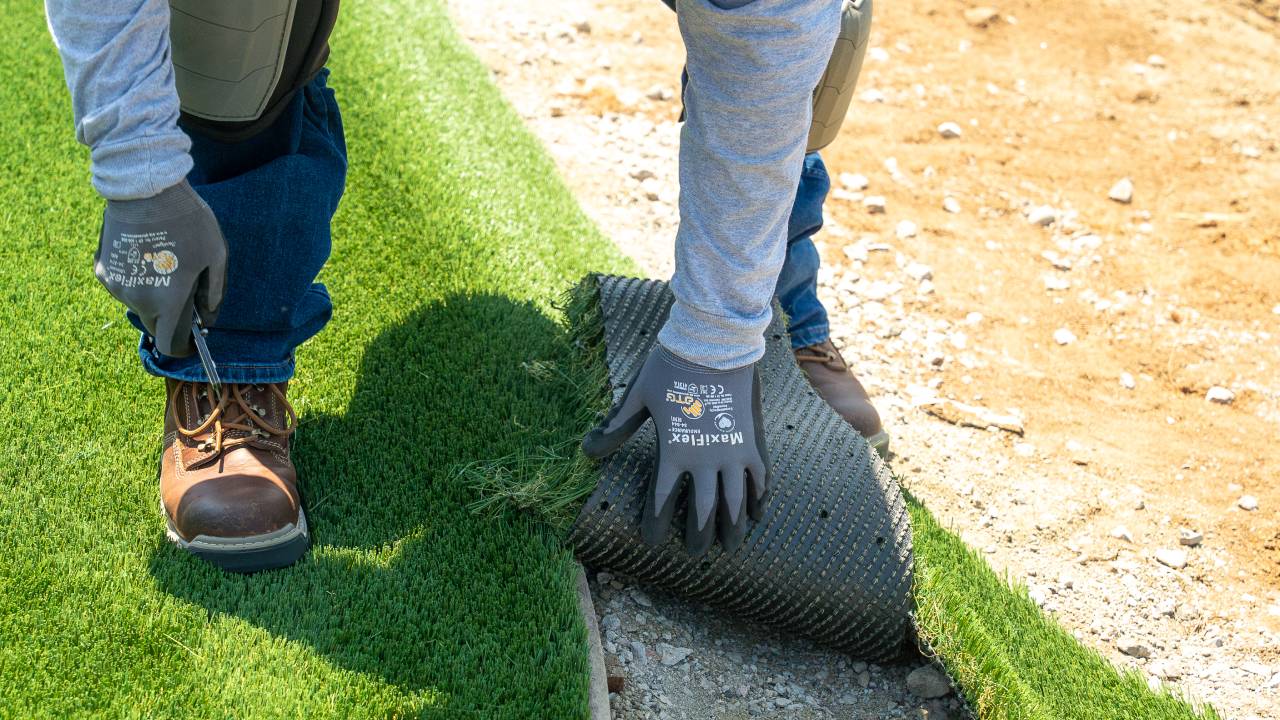Oh boy, the joys of lawn maintenance! You pulled the trigger on your very own low-maintenance artificial grass. Then, maybe a few seasons later, you started to see those first few weeds growing in artificial turf. Wait, but wasn’t artificial turf the answer to all your landscaping woes?! Well, don’t worry, my friend – I’ve been down this road before. And I’m bringing a whole wheel-barrel-full of hard-earned wisdom on how to treat weeds in artificial grass.
Stop Weeds Growing Through Turf
-
- Weeds mostly grow on the surface of artificial grass, not from underneath
- Regular maintenance and early removal are a must for weed control
- You have both natural and chemical options for treating weeds
- Proper turf installation does reduce weed growth likelihood
- Weed barriers can provide additional protection against invasive plants
Why Do Weeds Grow Through Turf?
Yep, I get it. If you’re like I was, you might be scratching your head and wondering, “How on earth can weeds grow through artificial grass?”
Well, here’s the (unfortunate) weed scoop: most weeds don’t actually grow in artificial grass from underneath. They’re more like opportunistic squatters, setting up shop on the surface. You see, weed seeds are nature’s little hitchhikers. They catch a ride on the wind. They hitch a lift on your dog’s fur. Or they even travel on the soles of your shoes. And once they land on your artificial grass, they can take root in the infill material between the blades.
In some rare cases, particularly persistent weeds like nutsedge might find a way to push through the backing of your turf. But for the most part, we’re dealing with surface-level interlopers.
So, what do we do about them?
Weed Prevention Starts With Preparation and Planning
Now we a little more about how these green gate-crashers operate. So let’s talk about preparation and planning. What’s the old saying? “An ounce of prevention is worth a pound of cure.” This is 100% true when it comes to stopping weeds growing through turf.
The first thing you’ll want to do is take a look at your yard before you install artificial grass. We have a whole article on preparing your space for turf, so feel free to explore that fully. But today, start by checking for any existing weed problems. If you do, you have to address them now! Do not pass Go and do not collect $200. Trust me, I learned this lesson the hard way when I ignored a small patch of crabgrass in my own yard. It did not go well. I’ve spent more time fighting that stuff than I have enjoying the lawn.
You also should look into installing a weed barrier fabric underneath your artificial grass. This extra layer of protection can work wonders in preventing annoying weeds from pushing up from below. How do you like that, weeds?! Ahem.
Proper Turf Installation Discourages Weeds
This isn’t an artificial grass installation article, but it really does make a difference with those weeds. A well-installed artificial lawn is your first line of defense.
So, my first (and strongest) suggestion is to talk to artificial grass professionals. The Artificial Turf Supply teams know what they’re doing. They’ll help you choose the right turf for your space, and they’ll get it done right. I can’t recommend this enough.
But for you DIY’ers, here’s a step-by-step guide to ensure your turf is installed like a pro:
-
- Remove existing vegetation and topsoil (about 3-4 inches deep).
- Install a layer of crushed stone or aggregate as a base (about 3-4 inches thick).
- Compact the base material thoroughly.
- Lay down a weed barrier fabric (optional but recommended).
- Install the artificial grass, ensuring proper seaming and securing.
- Add infill material to stabilize the turf fibers.
Remember, proper drainage is key. A well-draining base will prevent water from pooling, which can create a breeding ground for weeds and moss.
Soil Preparation and Weed Control
Even though we’re dealing with artificial grass, the preparation of you soil is still crucial. So this piece of advice should be used before you install your artificial grass. Treat the soil with a non-selective herbicide to eliminate any existing weeds and their seeds. Yes, this is a scorched-earth approach. But it gives your new turf a clean slate to start with.
If you’re like me, you’d really prefer environmentally friendly options. You can find many varieties of organic weed killers these days. Or, if you’re really hard-core, manually churning up the soil and removing all plant-life works well.
Does Edging Matter to Treat Weeds?
Yes, yes, and yes! Proper edging along your artificial grass border is essential for weed control. Drop in a sturdy edging material around the perimeter of your artificial lawn. You want a solid barrier between your turf and any surrounding natural areas. (Gotta keep those transient seeds from invading, right?)
Actually, the edging does two things:
-
- It provides a clean, finished look to your lawn.
- It prevents weeds from creeping in from the edges, which is a common entry point.
Pro tip: Use a metal or plastic edging that extends a few inches below the surface to create an effective root barrier.
Maintenance to Keep Weeds from Growing in Artificial Grass
I love that artificial grass lets you toss your mower in the trash. (Don’t actually do that … dispose of now-irrelevant machinery in planet-friendly ways, please.) But there are still some maintenanace practices that will help keep those weeds whwere they belong. Which is anywhere but on your turf.
Here’s what you should do:
-
- Brush your artificial grass regularly (once a month or so) to keep the fibers upright and distribute the infill evenly.
- Use a leaf blower or rake to remove debris like leaves and twigs that can decompose and create a fertile environment for weeds.
- Rinse your lawn occasionally to remove dust and pollen that might accumulate.
So go give your artificial grass a spa day – it’ll look better and be less hospitable to unwanted plant guests.
Natural Weed Control Methods
The eco-conscious among you have several effective, planet-friendly ways to waylay those weeds on your artificial grass:
-
- Vinegar solution: Mix equal parts water and white vinegar in a spray bottle. Add a squirt of dish soap to help the solution stick to the weeds. Spray directly on the weeds on a sunny day for best results.
- Boiling water: This method is simple but effective. Pour boiling water directly onto the weeds to kill them. Be careful not to pour it on the artificial grass, as extreme heat can damage the fibers.
- Manual removal: For small weed invasions, simply pulling them out by hand can be effective. Make sure to remove the entire root to prevent regrowth.
- Salt: Sprinkle salt directly on the weeds. While effective, use this method sparingly as salt can build up in the soil over time.
Chemical Weed Control Options
Sometimes the natural solutions don’t work. Sometimes the kitty gloves have to come off and you gotta bring out the big guns. Once again, you have multiple chemical weed control options to use on artificial grass:
-
- Non-selective herbicides: Products like Roundup can be effective, but use them cautiously and follow the manufacturer’s instructions.
- Pre-emergent herbicides: These prevent weed seeds from germinating and can be applied to your artificial lawn periodically.
- Weed and moss killers: Specialized products designed for artificial grass can tackle both weed and moss issues.
SAFETY REMINDER: always prioritize safety when using any chemical products. Keep children and pets off the treated area for the recommended time period.
Go Waylay Those Weeds, Friends!
Weeds on your artificial grass are super-annoying. But they’re definitely not invincible. Knowing how to prevent weeds growing through turf is about proper installation, regular maintenance, and a few tricks (that you now know).
But if you’d like some weed-fighting, artificial grass professional allies, give our team a call: (866) 677-9405
We’re always glad to help you keep your artificial lawn looking lush, green, and weed-free for years to come. So go ahead, enjoy your low-maintenance landscape, and show those weeds who’s boss!






